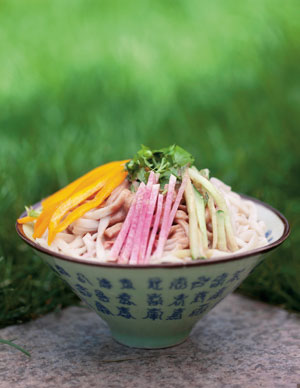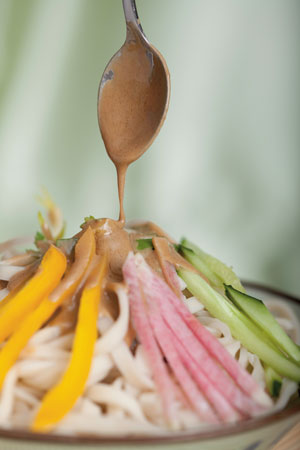
“The Chinese take a hostile stand against cold foods in general. They will seriously screw up your qi, sweltering weather or not”
Perfect outdoor weather in Beijing doesn’t come but once in a blue moon – but when the skies are sunny, there’s nothing that a tank top, a cold drink, and a slight bit of shade can’t tackle. Also necessary in the armory is a good working knowledge of cold dishes that require little or no cooking.
Despite its undeserved bad rap in the West, the ideal summer meal really is cold pasta. Noodles make it hearty and filling; crunchy, fresh veggies make it surprisingly light. The trick to pasta salad is an easy one: lots of tangy, extra flavorful dressing tossed while the pasta is still warm and slightly undercooked. Chinese cold noodles, which thankfully have been spared the indignity of side dish infamy, deviate slightly from this basic concept.
There is the majiangmian, or sesame paste noodles. Chinese sesame paste, a close cousin of tahini, is made from roasted white sesame seeds, unlike the Middle Eastern sauce, which is made from unroasted seeds. The roasting gives the paste a darker color and nuttier taste. Majiang, or sesame paste in its many thicknesses, is ubiquitous in a variety of cold Chinese dishes, where it sauces cucumbers, spinach, eggplant, rice or flour noodles. But a truly traditional majiangmian, no matter how cold, always sits a little heavy in my stomach – all that gluten working full speed ahead towards a coma. The perfect summer meal has to be lighter, juicier, crunchier.
For that I turn to the most famous of the cold noodles in Beijing, the zhajiangmian. Right, so the noodles aren’t exactly cold – more like room temperature. Culturally the Chinese take a hostile stand against cold foods in general, arguing that they will seriously screw up your qi, sweltering weather or not. (And thus the explanation for the strange benevolence to lukewarm beer.) The Chinese cook usually serves these noodles tossed with deeply savory fermented soybean paste (a thick, fragrant soy sauce) with thinly julienned cucumbers. The restaurant version, on the other hand, is served with cucumbers and thinly julienned bright pink radishes, pale fresh bean sprouts, and occasionally young soy beans.
Add to that some fresh cilantro, mint, or both, and this turns into the kind of salad-y noodle, served cold and crunchy, that’s perfect for a bright sunny day. Make the sauce ahead of time, julienne the veggies, cook the noodles (the freshly made ones are absolutely key – available at every Chinese supermarket) to just slightly underdone, and you’ll have all you need for a day in the sun (or shade).

Recipe
Sesame Noodles (Serves 4-6)
Ingredients
1 small red pepper
1 small yellow pepper
1/2 small pink radish
1 large cucumber
1/2 cup bean sprouts
1/4 cup loosely packed cilantro, mint or both
5 stalks of small green onion
1 kg freshly made Chinese noodles
2 tsp sesame oil

Sauce
4 garlic cloves, minced
3 tsp fresh ginger, minced
1/3 cup sesame paste (mix the paste as it tends to settle and separate)
1/4 cup of warm water
1 tsp sugar
2 tbsp light soy sauce (as opposed to dark)
1 tbsp Chinese vinegar, or lemon juice
Salt
Pepper
Chilli pepper/Sichuan pepper oil to taste (4-5 dried chilli peppers, 4-5 Sichuan peppers)
1/4 cup peanut oil
1. Steep garlic and ginger in about 1/4 cup of warm water. Set aside.
2. Make chilli oil now if using. (Break up
peppers with your hands. Heat 1/4 cup peanut oil in wok until barely smoking. Carefully pour hot oil into a heatproof bowl containing the peppers. Cool.)
3. While the oil cools and the garlic and
ginger steeps, cut all vegetables into thin strips. Roughly chop herbs.
4. Bring a pot of water to a rolling boil. Toss in noodles, stirring well, until just slightly under cooked (about four minutes). Drain. Run noodles under cold water. Drain well, toss with sesame oil, set in fridge to cool.
5. Drizzle garlic/ginger water, discarding the actual garlic and ginger, into the sesame paste until the sauce thins to the consistency of thick yogurt. Combine the rest of the sauce ingredients. Mix well.
6. Assemble veggies on top of noodles.
Drizzle sauce. Mix. Eat. The noodles can be made and packed



